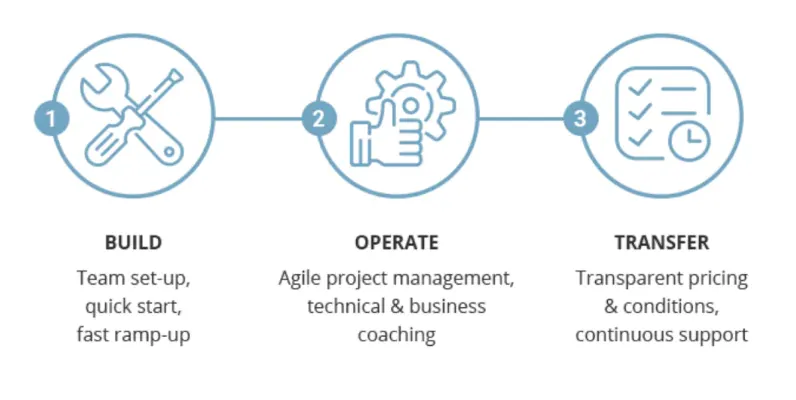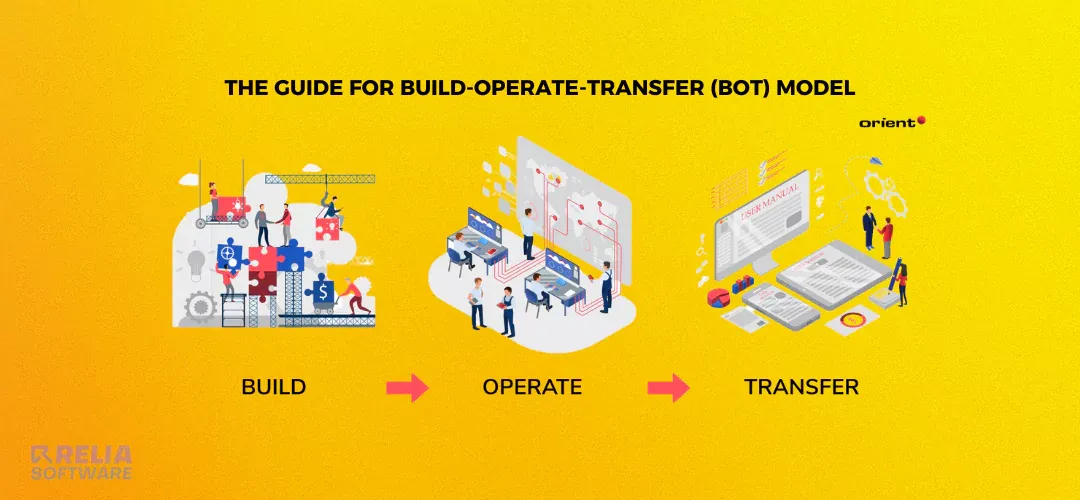The Build Operate Transfer (BOT) paradigm is useful for companies building, expanding, or entering new markets. This innovative strategy provides several benefits and a defined framework for the organization to achieve its goals.
The BOT (build-operate-transfer) model lets you use specialized partners' skills, resources, and finances to manage project stages. Collaborative collaboration helps the organization negotiate complicated projects and unlock important advantages that can boost growth, reduce risk, and improve efficiency.
Build-Operate-Transfer Model Definition
Build-operate-transfer (BOT) is a contract in which an organization hires a service provider to set up, optimize, and run software development. Otherwise, it also can be a business process service delivery operation with the intent of transferring it to the organization as a captive center. BOT is a hybrid approach that combines “build” (insourcing) and “buy” (outsourcing; see also “captive centers”).
The BOT model works well when a business needs to quickly make a new product or subsidiary that does not have experience with it or to swiftly establish a team in a new country. When the contract is over, full ownership is given to the person who asked for the job.
In the BOT model for software development, the company that is hired builds the product from start to finish. When the product is ready, the company that asked for it will own it, along with any infrastructure it needs and some people to keep it running. Website development or mobile app development are good projects for the build-operate-transfer (BOT) model.
>> Read more:
- Detailed Breakdown for Offshore Software Development
- In-house VS Outsourcing Software Development
- IT Staff Augmentation: Development Team Growth Method
- Unlock the Power of An Offshore Development Center (ODC)
3 Phases of the BOT Model
The build-operate-transfer (BOT) model involves a three-stage software lifecycle for large-scale projects. Here is the breakdown of the 3 phases of the BOT model:
Construction (Build)
At this time, the team is being built and put together on the vendor side. The goal is to make sure the team is ready to work within the rules of the country and use its back-office help in areas like HR and finance.
This is also the case when both sides agree on the rules and limits of the work to be done together. The provider companies look closely at the standards to figure out what skills and knowledge the new team needs.
The project can then begin the process of finding the right technologies, team members, office space, and tools, all based on the needs of the clients.
For details, the building phase will have these steps:
- Establishing partnership rules: Separating issues is essential for good cooperation. The BOT approach should be customized to the client's demands. And the project cost also has to be shown transparently to the client.
- Recruitment: Most IT consultancy firms that offer BOT solutions recruit heavily. That means better local talent access and brand recognition in some cases. The vendor's knowledge of local employment and relocation legislation can greatly speed up recruitment.
- Office setup: This process involves vendors selecting the correct site and installing Internet connection, servers, workstations, and other equipment, software, and security regulations.
- Lawful activities: The vendor will have to establish the subsidiary company if the client company requests it and takes all legal actions in their nation. The vendor must rent a separate office space if the clients need to.
- Sharing knowledge and training: Vendor and client companies collaborate to give workers the knowledge they need to start. They learn about your company culture, operations, procedures, project technical needs, and business goals.
Operation (Operate)
At this point, the provider focuses on managing the offshore crew in collaboration with the client company. The supplier side also provides local assistance and ensures that the staff is completely integrated and aligned with the client company objectives.
By devoting a significant amount of time to operations, the provider can collaborate with the team and ensure that all important procedures are properly aligned. This is also when the client sets up time and resources to train the team, which might include a series of seminars followed by one-on-one meetings with each team member.
Then, the process will involve ongoing maintenance, ensuring system uptime, and security updates, and potentially providing user support depending on the agreement. Clients also have to establish key performance indicators (KPIs) to monitor service delivery quality, security standards, and adherence to the agreed-upon service levels.
Transfer (Ownership Transfer)
This is the step where ownership is transferred. When the project ends, the provider passes the whole information and developing team to clients, including all of the expertise and abilities gained throughout the operations stage.
However, this occurs only when the client declares that it is ready to control the project fully or when the contract expires. A good service agreement and months of vendor preparation will make the move easy.
A transfer team will conduct the transfer process. It includes:
- Transfer ownership of assets, processes, and employees to the contractual enterprise.
- Charge the client a one-time transfer charge to give up employer rights.
- Transfer office space and assets to the client.
- Transfer any intellectual property or knowledge base to the client.
- Return all procedures and departments to the client, including training, HR, and finance.
Sometimes staff will sign new contracts with the client, or the vendor company creates a subsidiary company for this relationship and gives the client full ownership.
After the transfer process is completed, the transfer team is usually disbanded. The operations team of the client would subsequently be responsible for overseeing the team that receives project deliverables.
The transfer phase does not usually conclude the commercial relationship. BOT providers usually offer legal, HR, and recruitment services. If cooperation has been successful, securing your vendor's continued support in a new capacity may be useful.
On the other hand, the transfer fee is also an important part of the contract.
- The service provider may impose a one-time transfer fee of 20-30%, based on contractual obligations.
- During the build phase, this amount is usually included in the annual fee, which may be predefined in the service contract between the customer and supplier.
- The service provider will charge a one-time transfer fee to renounce employer rights over rebadged resources.

>> Read more:
- Cross-Platform App Development: Top 5 Best Frameworks
- What is Ruby on Rails? Master A Popular Web App Framework
Advantages and Disadvantages of the BOT Model
Advantages
Less Cost
Companies seeking extra software developers or startups seeking a cheaper workforce use the build-operate-transfer concept. These companies may not have the time or money to build an office, hire staff, etc. This is especially true if the company is expanding overseas. This technique can help many sectors fill their skills deficit without the time and expense of hiring.
Access Global Talent
The build-operate-transfer model for IT services gives a good partner access to top talent worldwide. The build-operate-transfer (BOT) model provider establishes an IT services operation from scratch. This procedure comprises setting up the business, hiring staff, and preparing legal and administrative documents.
Build-operate-transfer model providers address client needs when hiring to select the finest candidates for the team. They find talent while saving money on legal entity formation in that country. The supplier can provide 24/7 coverage with staff in different time zones.
Save Overhead
IT services and team management are handled by the provider. They help the client's remote IT developer operation launch and scale up smoothly. This level involves all managerial roles, eliminating administrative, accounting, and legal overhead. BOT enterprises also avoid the trouble and long-term commitment of leasing office space and organizing utilities and internet.
Explore Experience Team
The organization will give the whole remote IT crew to the clients, whenever they are ready. The receiving company buying the new staff has helped with everything from office space to utilities to vendor searches. Best of all, the acquiring firm knows the IT team and how they function as this is the same team from the start.
Minimizing risk
The BOT model shares software development risks between the company and the third-party supplier. The supplier manages project execution, deadlines, and quality. This eliminates technological, resource, and software delivery risks, allowing the company to focus on its core business.
IT outsourced external providers have specific obligations and risks associated with delivering outsourced services. Riskier than Build-Operate-Transfer, the company is responsible for the software solution or IT infrastructure's success.
Disadvantages
Limited Control
The BOT model generally contains performance requirements and service level agreements, although the client organization may have little control over the third-party provider's quality and service during operations. The company relies on third-party suppliers for service quality and performance.
Transfer Risks
The Build Operate Transfer paradigm requires compliance with regulations, laws, and transfer processes for control transfer. Legislative changes, bureaucratic procedures, and ownership transfer conflicts can delay or complicate power transfers.
Culture Differences
Last but not least, the acquiring companies and the overseas teams may experience culture shock because they are from different countries and cultures. They should get to know their teams and teach their culture so that everyone can understand each other better.
Talk to employees about the transfer and its effects to avoid anxiety or doubt. Answer questions about the expansion and introduce the distant workers to the client's local workforce. Company productivity increases by 25% with networked personnel, according to Bluescource.
Compare the BOT Model To Other Outsourcing Models
The Build-Operate-Transfer (BOT) model stands out from other outsourcing models due to its unique structure and long-term project focus. Here's a breakdown comparing BOT with two common alternatives:
Staff Augmentation
While staff augmentation caters to more immediate staffing needs, BOT is suited for large-scale infrastructure projects. BOT involves significant financial risk sharing, whereas staff augmentation typically involves minimal risk for the outsourcing company.
In BOT, the client gains ownership of the project after the transfer phase; staff augmentation doesn't involve asset ownership transfer.
>> Read more: Staff Augmentation VS. Outsourcing: Which Is Better?
Managed Services
Both BOT and managed services involve ongoing collaboration between the client and the external party. BOT has a defined project lifecycle with a transfer of ownership, while managed services are typically ongoing.
BOT deals with large-scale infrastructure, while managed services can encompass a wider range of operational functions.
>> Read more: The Comparison of Staff Augmentation VS Managed Services
Here is a detailed table comparison of these outsourcing services:
| Feature | BOT Model | Staff Augmentation | Managed Services |
| Focus | Long-term infrastructure projects | Short-term to medium-term projects/ongoing operational support | Ongoing management of a specific business function |
| Client Role in Management | Limited during the operation phase, full control over project goals | Full control over project management and deliverables | Shared control based on Service Level Agreement (SLA) |
| Financial Structure | The client pays for financing, construction, and potentially revenue sharing with the concessionaire | The client pays a fixed fee or hourly rate for resources | The client pays a recurring fee based on the agreed-upon service level |
| Risk Sharing | Significant risk sharing between the supplier and receiver | Client bears most project risks | Varying levels of risk sharing depending on the agreement |
| Ownership Transfer | The client gains ownership after the transfer phase | No asset ownership transfer | No asset ownership transfer |
| Suitability | Large-scale projects requiring the provider's expertise and financing | Immediate staffing needs | Ongoing operational support requiring specialized expertise |
Factors to Consider When Choosing BOT Models
The Build-Operate-Transfer (BOT) model can be a complex undertaking, and its suitability depends on various factors. Here's a breakdown of key considerations for public sector entities contemplating the BOT approach:
- Project Characteristics: Is it a large scale with high upfront costs? Traditional IT outsourcing might be better suited for smaller or less complex projects.
- Long-Term Vision: Clearly define the project's purpose and long-term goals. Can the private sector effectively manage upgrades and ongoing maintenance within the BOT framework?
- Risk Allocation Strategy: Develop a comprehensive risk-sharing plan that addresses potential cost overruns due to technology fluctuations or technical challenges during development and operation.
- Contract Design: Craft a watertight contract outlining roles, responsibilities, performance expectations, and a clear exit strategy (ownership transfer or continued private sector involvement) at the end of the concession period.

Conclusion
The build-operate-transfer (BOT) model enables companies to outsource large, risky outsourcing firms to a private entity. However, many elements might turn a dream deal into a nightmare, especially for a risk-taking private corporation. Thus, selecting a reputable BOT partner is crucial.
With the priority of giving quality materials and supporting customers' needs, Relia Software developers' team prides itself on expediting the Build-Operate-Transfer model process for you with software development.
>>> Follow and Contact Relia Software for more information!
- outsourcing

